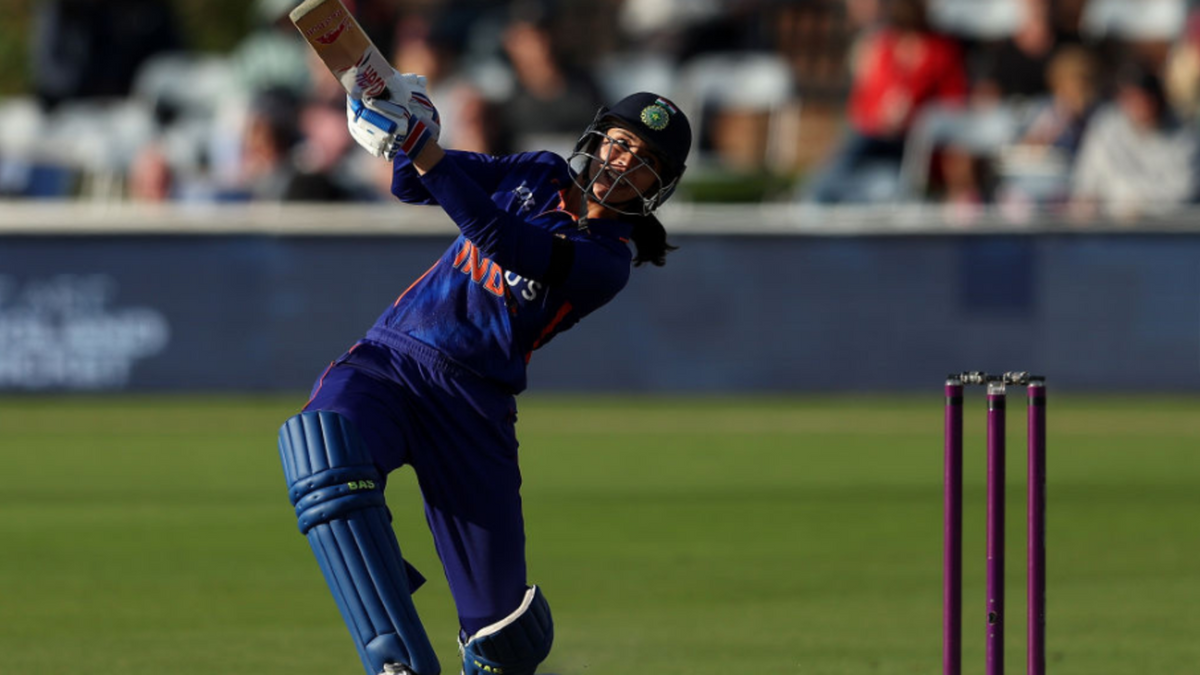
Smriti Mandhana’s achievements belie her age – despite being only 26, she’s established herself as a superstar, consistently scoring runs across formats for India.
The second ODI against England this week was all about Harmanpreet Kaur and her monstrous 143*, but setting the tone upfront was Mandhana, who stroked a fine 40 from 51 deliveries at the top of the order. The last game on Saturday had Jhulan Goswami, playing her last international game, in focus, but it was Mandhana who ensured the stalwart had something to bowl at after arresting a collapse by making 50 from 79. It was her eighth 40-plus score in ODIs this year – a tally that includes one hundred and two nineties.
The opener has made 696 ODI runs this year at an average of just under 50, with her sole hundred coming in the World Cup against West Indies. Her tally is the third-highest in the world in 2022, and second-most amongst all India batters, behind only Harmanpreet, who has 754 runs in the last nine months. Mandhana has been able to keep the carnage going in the shortest format as well, making 332 runs from 11 games – the second-most in the world among players from Full-Member countries. Kaur lurking close behind with 295 runs, at an average of 36.87, very similar to Mandhana’s 36.88.
Kaur, however, did not have a consistent run in either format for over three years. She had not made more than 60 in ODIs since her epic 171* against Australia in 2017 before this year and did not cross fifty following her T20 World Cup hundred in 2018. When Mithali Raj was in the set-up, her strike rate was always a talking point. The former captain’s 1,255 runs since 2019 in ODIs were scored at a strike rate of 65.91 – and ever so often, the runs accumulated had to be viewed from a wider lens.
Mandhana, aware of the issues plaguing the two-most senior batters in the side, redefined her game accordingly, looking to not only bat deeper but also score quicker. Since 2019, she has made 1,471 ODI runs, having played nine matches fewer than top-placed Laura Wolvaardt, who has 1,774 runs. Only Alyssa Healy has scored more runs and averages better than Mandhana’s 49.03, but what also stands apart is her strike rate of 86.02. Only three batters – Healy, Nat Sciver and Mandhana – have made more than 1,000 runs and have a strike rate in excess of 85. The fact that Mandhana constantly ranks amongst the greats already is a testimony to how effective she has been across various parameters.
Overall, Mandhana has 3,073 runs in 77 ODIs, reaching the 3,000-run mark in 76 innings in Canterbury. She became the quickest women’s player from India to the landmark and was the third-fastest from her country after Shikhar Dhawan (72 innings) and Virat Kohli (76 innings).
Her performances in T20Is, where the problems for India ran deeper without the presence of Raj, further show her impact. Since the start of 2019, Mandhana is the highest run-scorer in the shortest format – making 1,257 runs with a strike rate of 130.52. Unlike the men’s game, where a strike rate in the 130s will be frowned upon, a strike rate above 125 in the women’s game is laudable. For context, only three batters have made 770 or more runs in the format in this period and struck at over 130 – Mandhana, Shafali Verma (925 runs, SR: 137.03) and Healy (770 runs, SR: 136.76). With 11 fifties to her name – joint-highest with Beth Mooney – she is an all-round star.
Her impact is doubled when we take a look at how the other India batters have fared in this period.
No other India batter comes close to Mandhana’s run-tally, and no other batter averages more than 30 with a strike rate above 130. More strikingly, Mandhana has made 11 fifties alone, while all other batters have combined to score 10. The gap between her and her own teammates is immense, which is also reflected in India’s winning pattern.
That is a huge responsibility for a player aged just 26 years. While it signifies how misfiring the middle order has been for India, on the other hand, it displays the class of Mandhana and how she has remained unfazed even with bigger burdens.
Mandhana’s maiden Test hundred last year – a knock of 127 in Australia – to go with a 78 against England, further establishes her status as an all-format superstar, who has remained zen-like in the biggest of occasions. At an age when she should be cushioned by the senior players in her side, India’s vice-captain has to lead from the front with the bat without the safety nest that should ideally have been provided to her.
Mandhana, though, seems to relish the added duties, and more than what she has achieved, the prospect of what she can go on to carve out in the future remains tantalising.








